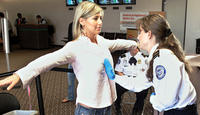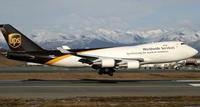-
Qaeda's new tactics: heavy economic damage, low-cost operations
In a detailed account of its failed parcel bomb plot three weeks ago, al Qaeda’s branch in Yemen said late Saturday that the operation cost only $4,200 to mount, was intended to disrupt global air cargo systems and reflected a new strategy of low-cost attacks designed to inflict broad economic damage; the organization said the fear, disruption, and added security costs caused by the packages made what it called Operation Hemorrhage a success
-
-
Q&A: Full-body scanners
Questions are being raised about the privacy and health aspects of wide use of full-body scanners; here is one example: millimeter wave scanners, in theory, ought to be safer than X-rays because millimeter photons do not have enough energy to break chemical bonds; last year, however, researchers at Los Alamos National Laboratory found that while these photons cannot break DNA, they can shake it: this shaking may be so strong that it unzips the two strands in DNA, interfering with the genetic machinery that keeps cells working and healthy
-
-
TSA struggles to balance security, privacy

Travelers at U.S. airports who refuse to be screened via new full body scanners must undergo an extensive hand search, which include touching of the genital region and breasts; John Pistole, head of TSA, said he understood privacy concerns, but security was paramount; a new poll out on Tuesday suggested that eight out of ten Americans support full body X-ray machines being installed throughout the United States to help security officials check underneath passengers’ clothing; John Tyner, 31, who was thrown out of San Diego International Airport after refusing both a full-body scan and a pat down, faces a $10,000 fine if he is sued by the TSA
-
-
Manchester Airport conducts distance biometrics trial
Manchester Airport begins a 2-week trial of a system which can recognize an individual’s iris while they walk around; the system might allow international transfer passengers to mix with domestic passengers in a departure lounge because they can be securely identified before boarding their flight
-
-
Communications gap allowed packet bomb to go unchecked
German customs officials wanted to search last week’s package containing a bomb from Yemen, but it had left the country by the time the paperwork arrived; a communications breakdown enabled the explosive to pass through Germany without security checks; the security gap at the Cologne-Bonn Airport meant that the explosive-laden printer from Yemen avoided customs
-
-
Full-body scanners at U.S. airports may be dangerous: scientists
U.S. scientists warned that the full-body, graphic-image X-ray scanners now being used to screen passengers and airline crews at airports around the country may be unsafe; scientists say that most of the energy from the scanners is delivered to the skin and underlying tissue; “While the dose would be safe if it were distributed throughout the volume of the entire body, the dose to the skin may be dangerously high,” they say
-
-
Mail bomb timed to explode over eastern U.S.

British police investigators say that forensic evidence showed the explosive device hidden inside an ink cartridge, originally sent from Yemen by way of Cologne, Germany, was timed to be detonated about six to seven hours after the cargo aircraft carrying it left the United Kingdom for the United States — meaning that it could have exploded over the East Coast of the United States; the UPS cargo plane intercepted in England left the country without the package at 11:20 p.m. ET on 28 October, two hours after landing, police said; the device was timed to be activated at 5:30 a.m. ET, said British police
-
-
Shippers campaign against full screening of cargo on planes
The TSA decided that starting last August, it would mandate the screening of all cargo on passenger planes loaded in the United States; it said its rule would not apply to cargo placed on U.S.-bound passenger flights overseas, or to cargo-only flights; the Obama administration announced new cargo rules Monday banning freight out of Yemen and Somalia; it also restricted the shipment of printer and toner cartridges weighing more than a pound on all passenger flights and some cargo flights; the overall cargo security rules were unchanged
-
-
Better bomb sniffer built
Chemists have developed a sensor that detects minute amounts of TATP, an explosive favored by terrorists because it is easy to make and difficult to detect; TATP is easy to make from readily available ingredients: acetone, hydrogen peroxide, and an acid; since none of these ingredients contains nitrogen, the most common target for current bomb-sniffing technologies, TATP is especially difficult to detect
-
-
DHS tightens air cargo security measures
In the wake of the failed air cargo plot, DHS has announced a series of measures to tighten air cargo security; among the measures: no high risk cargo will be allowed on passenger aircraft; toner and ink cartridges over sixteen ounces will be prohibited on passenger aircraft in both carry-on bags and checked bags on domestic and international flights in-bound to the United States
-
-
Germany pushes EU air cargo security plan
Germany has demanded that the European Union draw up a blacklist of unsafe foreign freight dispatchers as part of an urgent plan to improve air cargo security on board passenger planes following bomb plots originating in Yemen and Greece
-
-
Aviation security market to reach $289 billion by 2015
Analysts estimate that the aviation security market will reach $289 billion by the year 2015; air carriers around the world are set to take delivery of 29,400 planes with a total value of $3.2 trillion by 2028 — and governments and carriers alike are eager to create a robust security foundation for this growing fleet
-
-
Al Qaeda plot to use kamikaze dogs failed
Al Qaeda operatives in Iraq tried to bring a plane down by deploying a pair of kamikaze canines on a U.S.-bound airplane; terrorists placed the bombs inside the dogs’ bodies, then took the dogs to the Baghdad airport in kennel carriers, destined for a flight to the United States; the plot failed because the bombs were so poorly stitched inside the dogs, that the dogs died
-
-
New liquid explosives screening technology deployed
The deployment of two new liquid explosive detection devices — HI-SCAN 6040aX by Smiths Detection and the Bottle Scanner from Kromek — will likely be the first step toward lifting restrictions that prohibit passengers from carrying more than 3.4 ounces of liquid or gel aboard an aircraft
-
-
German air shipping industry warns against overreaction on air freight security
German security expert says that, as with the illegal drugs trade, the only practical solution is to infiltrate the criminal organizations themselves; “If [technological solutions] worked, we would not have illegal drugs going to the U.S.—- But we have hundreds of tons being illegally imported to the U.S. every year”
-
More headlines
The long view
New Technology is Keeping the Skies Safe
DHS S&T Baggage, Cargo, and People Screening (BCP) Program develops state-of-the-art screening solutions to help secure airspace, communities, and borders
